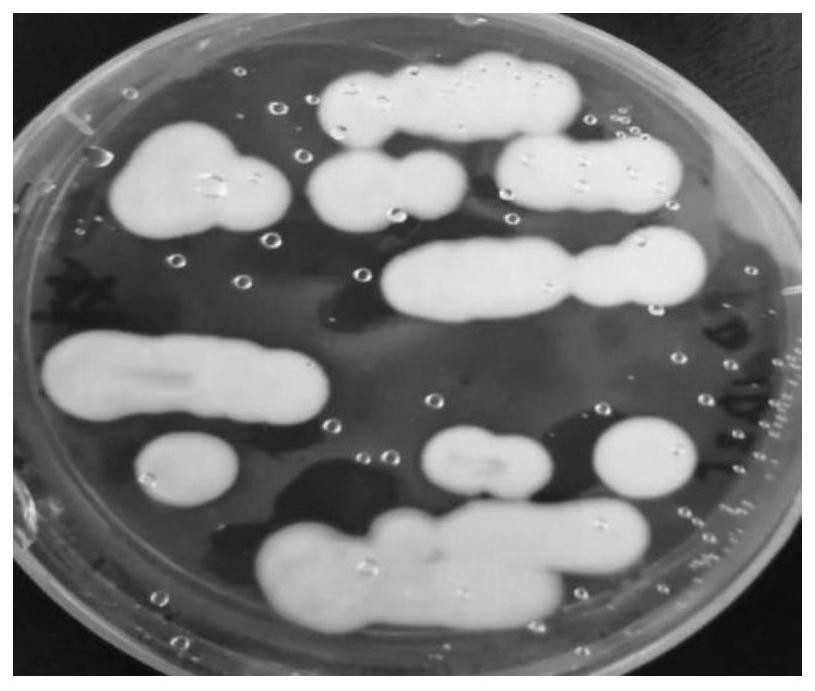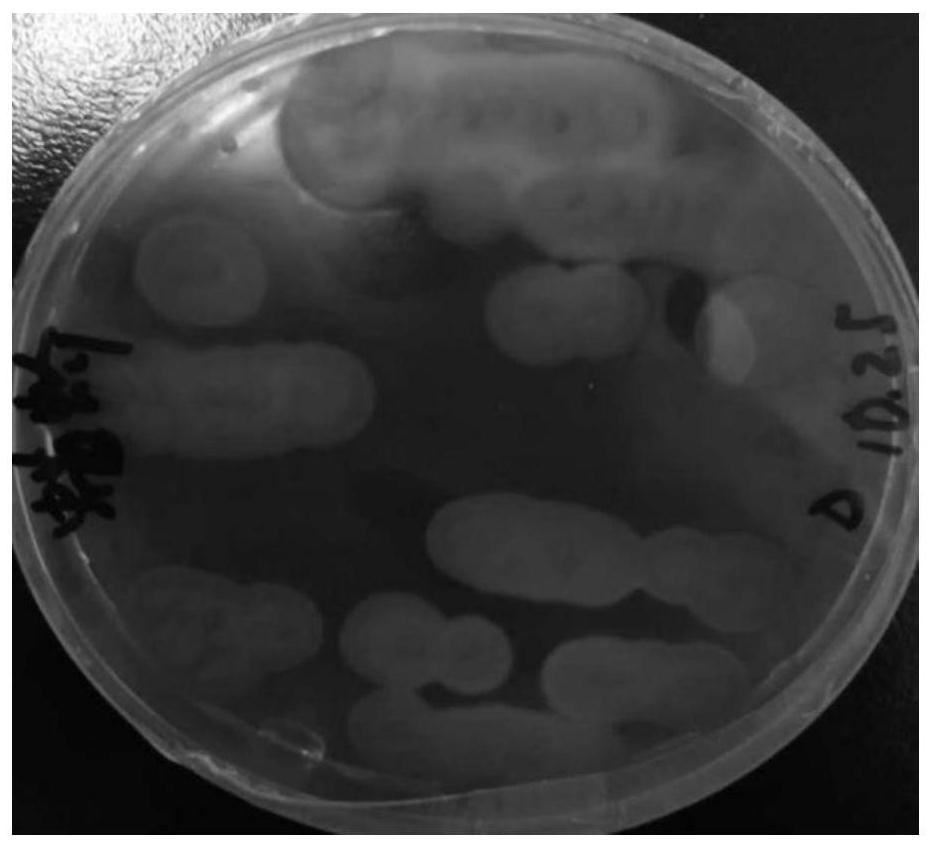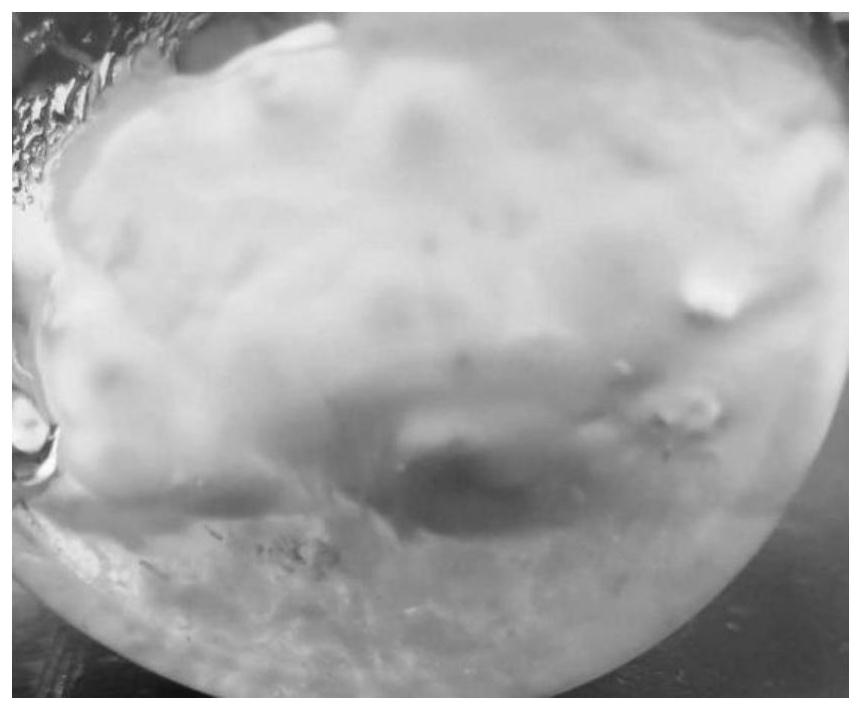A Lecanococcus spp. capable of inhibiting Fusarium pathogenic bacteria and its application
A technology of Cyclocystis serrata and Fusarium spp. is applied in the fields of microorganisms and agriculture, and can solve the problems of no development of biological drug root rot, environmental pollution, drug residues, etc. The effect of bacteria-plant symbiosis
- Summary
- Abstract
- Description
- Claims
- Application Information
AI Technical Summary
Problems solved by technology
Method used
Image
Examples
Embodiment 1
[0034] Embodiment one bacterial strain is isolated
[0035] Rinse the excavated healthy Gansu Fritillaria and Angelica sinensis with running water for 10 minutes, blot the surface moisture with filter paper, cut off the roots of Fritillaria and Angelica sinensis, rinse 3-4 times with sterile distilled water, 75% Soak in ethanol for 30s, then rinse with sterile water for 2 to 3 times, then sterilize with 0.2% mercuric chloride for 10 minutes, then rinse with sterile water for 3 to 4 times, and use 100 μl of sterile water after the final rinse to smear the plate on Tiger Red Solid medium served as a control.
[0036] Use sterilized filter paper to dry the surface moisture of Fritillaria and Angelica explants after surface disinfection, cut the explants into about 1 cm with a sterilized knife, take 1 g and place them in a high-temperature dry-heat sterilized container at 200 °C. In the mortar, add 10ml of sterilized physiological saline, and grind thoroughly.
[0037] The stock...
Embodiment 2
[0039] Example two strain identification
[0040] Inoculate the different bacterial strains obtained in Example 1 into liquid PDA medium, culture them at 28°C and 200rpm for 7-10 days, collect the bacteria by centrifugation at 4°C and 5000rpm, and extract the genomic DNA with the SDS method after the tissue disruptor is fully broken , used for PCR amplification after electrophoresis detection. Primers are:
[0041] ITS1: 5'-TCCGTAGGTGAACCTGCGG-3'
[0042] ITS4: 5'-TCCTCCGCTTATTGATATGC-3'
[0043] The PCR reaction system is 50μl: 5× Buffer (Mg 2+ plus) 10μl, forward and reverse primers 2μl each, dNTP Mixture (each 2.5mM) 4μl, HS DNA Polymerase (2.5Μ) 0.5μl, DNA template 1μl, ddH 2 O 31.5 μl.
[0044] PCR amplification conditions: denaturation at 98°C for 10 sec; annealing at 56°C for 15 sec, extension at 72°C for 1 min and 30 sec, 30 cycles, and extension at 72°C for 5 min. The amplified products were sent to Beijing Qingke Xinye Biotechnology Co., Ltd. for sequencing...
Embodiment 3
[0047] Example 3 Qualitative Detection of Nitrogen Fixation Activity of Lecanococcus spp. BMDBLJJ-1
[0048] Prepare Ashubei culture medium, add 0.5% Congo red 5ml / L, sterilize and make a plate for use, pick a small amount of mycelia from the edge of the preserved Lecanococcus sp. culture medium at 28°C in the dark for 10 days, and observe the growth of the colonies.
[0049] Congo red is a brownish-red powder, which is yellow-red when dissolved in water and orange when dissolved in alcohol. It is used as an acid-base indicator with a color change range of 3.5 to 5.2. It is red in the alkaline state and blue-purple in the acid state. Nitrogen fixation by bacteria BMDBLJJ-1 is in an alkaline state, shown as a red circle. The size of the circle and the depth of the color can reflect the strength of nitrogen fixation ability to a certain extent.
[0050] Experimental results such as Figure 6 As shown, the colonies on the nitrogen-free ashibe culture medium were clearly visibl...
PUM
 Login to View More
Login to View More Abstract
Description
Claims
Application Information
 Login to View More
Login to View More - R&D
- Intellectual Property
- Life Sciences
- Materials
- Tech Scout
- Unparalleled Data Quality
- Higher Quality Content
- 60% Fewer Hallucinations
Browse by: Latest US Patents, China's latest patents, Technical Efficacy Thesaurus, Application Domain, Technology Topic, Popular Technical Reports.
© 2025 PatSnap. All rights reserved.Legal|Privacy policy|Modern Slavery Act Transparency Statement|Sitemap|About US| Contact US: help@patsnap.com



